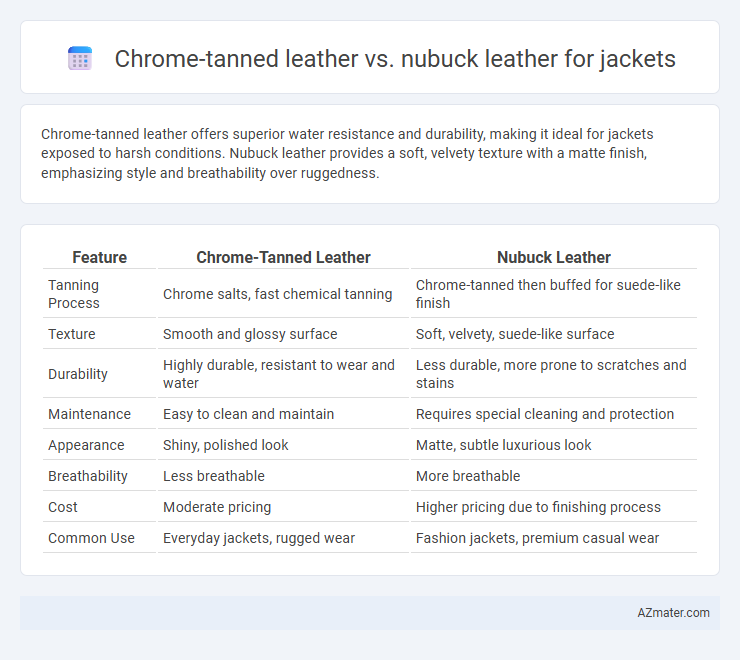Chrome-tanned leather offers superior water resistance and durability, making it ideal for jackets exposed to harsh conditions. Nubuck leather provides a soft, velvety texture with a matte finish, emphasizing style and breathability over ruggedness.
Table of Comparison
| Feature | Chrome-Tanned Leather | Nubuck Leather |
|---|---|---|
| Tanning Process | Chrome salts, fast chemical tanning | Chrome-tanned then buffed for suede-like finish |
| Texture | Smooth and glossy surface | Soft, velvety, suede-like surface |
| Durability | Highly durable, resistant to wear and water | Less durable, more prone to scratches and stains |
| Maintenance | Easy to clean and maintain | Requires special cleaning and protection |
| Appearance | Shiny, polished look | Matte, subtle luxurious look |
| Breathability | Less breathable | More breathable |
| Cost | Moderate pricing | Higher pricing due to finishing process |
| Common Use | Everyday jackets, rugged wear | Fashion jackets, premium casual wear |
Introduction to Leather Types for Jackets
Chrome-tanned leather is processed using chromium salts, resulting in a durable, water-resistant, and supple material ideal for jackets that require longevity and ease of maintenance. Nubuck leather, derived from top-grain cowhide, is sanded on the grain side to create a soft, velvety texture that offers a luxurious feel but requires more careful handling and protection against stains and moisture. Both leather types provide distinctive aesthetics and functionalities, influencing jacket style choices based on durability, comfort, and intended use.
What is Chrome-Tanned Leather?
Chrome-tanned leather is processed using chromium salts, primarily chromium sulfate, which significantly speeds up the tanning process compared to traditional vegetable tanning. This method produces leather that is supple, water-resistant, and has a consistent color, making it ideal for durable, stylish jackets. Chrome tanning also enhances the leather's ability to retain its shape and resist wear, providing long-lasting comfort and a smooth finish.
What is Nubuck Leather?
Nubuck leather is a type of top-grain leather that has been sanded or buffed on the grain side to create a soft, velvety surface with a slight nap. Unlike chrome-tanned leather, which undergoes a chemical tanning process using chromium salts to achieve durability and water resistance, nubuck is often chrome-tanned but distinguished by its unique texture and matte finish. Jackets made from nubuck leather offer a luxurious feel and a vintage look, but require careful maintenance to protect against stains and moisture.
Key Differences Between Chrome-Tanned and Nubuck Leather
Chrome-tanned leather is chemically treated with chromium salts, resulting in a soft, durable, and water-resistant material that resists wrinkles and maintains color vibrancy, making it ideal for jackets exposed to various weather conditions. Nubuck leather, a top-grain cowhide sanded on the outer surface, offers a velvety texture with a matte finish but requires more maintenance due to its susceptibility to stains and water damage. The key differences lie in their tanning process, surface texture, durability, and care requirements, with chrome-tanned leather providing enhanced resilience and Nubuck emphasizing a premium, natural suede look.
Appearance and Texture Comparison
Chrome-tanned leather for jackets offers a smooth, glossy appearance with a consistent texture that enhances durability and water resistance. Nubuck leather, by contrast, features a soft, velvety surface achieved through buffing the outer grain, providing a matte finish with a more natural and luxurious feel. The textured nap of nubuck is more susceptible to stains and requires careful maintenance, while chrome-tanned leather maintains its polished look with less upkeep.
Durability and Longevity
Chrome-tanned leather offers superior durability due to its chemical tanning process, which enhances resistance to water, heat, and wear, making it ideal for long-lasting jackets. Nubuck leather, although softer and more breathable with a velvety texture, tends to show scratches and stains more easily, reducing its overall longevity compared to chrome-tanned leather. For jackets requiring extended durability and resilience in various conditions, chrome-tanned leather remains the more practical choice.
Comfort and Breathability
Chrome-tanned leather offers enhanced softness and flexibility, making it comfortable for extended wear, while its tanning process provides moderate breathability suitable for various climates. Nubuck leather, sanded on the grain side, has a velvety texture that improves softness but typically allows more air permeability, enhancing breathability and comfort in warmer conditions. Choosing between the two depends on balancing the desired softness of chrome-tanned leather with the superior breathability and plush feel of nubuck for optimal jacket comfort.
Maintenance and Care Requirements
Chrome-tanned leather jackets require regular cleaning with a damp cloth and occasional conditioning using specialized leather products to maintain suppleness and prevent cracking. Nubuck leather, with its delicate, brushed surface, demands gentle brushing with a nubuck brush and prompt stain treatment using specific nubuck cleaners to preserve its velvety texture and avoid discoloration. Both materials benefit from protection sprays against moisture and stains, but nubuck is generally more sensitive to water and oils, necessitating extra care during wear and maintenance.
Cost and Value for Money
Chrome-tanned leather jackets typically offer a more affordable price point due to faster tanning processes and higher production efficiency, providing good value for those seeking durability and water resistance. Nubuck leather, with its delicate sanding to create a soft, suede-like texture, commands a higher cost reflecting its premium craftsmanship and luxurious appearance. Investing in chrome-tanned leather maximizes value for money through longevity and ease of care, while nubuck prioritizes aesthetic appeal and softness, often requiring more maintenance and a higher initial investment.
Which Leather is Best for Jackets?
Chrome-tanned leather offers superior durability, water resistance, and vibrant color retention, making it ideal for jackets that require long-lasting wear and easy maintenance. Nubuck leather, with its soft, velvety texture and matte finish, provides a stylish and breathable option but demands more careful upkeep and is less resistant to moisture. Choosing the best leather for jackets depends on prioritizing either rugged durability and low maintenance (chrome-tanned) or premium softness and aesthetic appeal (nubuck).

Infographic: Chrome-tanned leather vs Nubuck leather for Jacket
 azmater.com
azmater.com